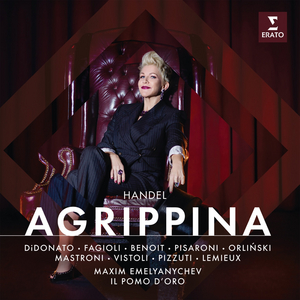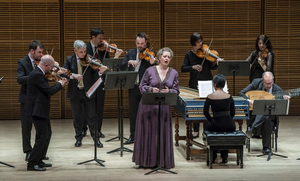Reviews: Going for Baroque – Orlinski's FACCE D'AMORE on Erato, Hallenberg with VENICE BAROQUE at Zankel

Someone once asked me, long ago, "Don't you ever get Baroque-d out?" The answer then--when instrumental music was more widely available than vocal--was a firm "no."
Today, when the music of Handel and his contemporaries is everywhere, my answer remains the same, particularly when it's in the right hands, like Joyce DiDonato (JDD) in AGRIPPINA, heard last year in concert at Barcelona's Liceu and more recently at the Met, as well as on CD and vinyl. There are also some less familiar--but very much worthy--names, like countertenor Jakub Jozef Orlinski on his latest Erato CD, "Facce d'Amore," and mezzo Ann Hallenberg, performing with the Venice Baroque Orchestra last week at Carnegie's Zankel Hall.
Orlinski's "Facce d'Amore" (Erato)
I first heard Orlinski in Cavalli's LA CALISTO, as the shepard Endimone, when he was still at Juilliard in 2016. It also happens to be the source of the first aria, "Erme e solinghe cime...Lucidissima face," on the CD (Erato 607246), self-described as "painting the musical of the male lover in the Baroque." The opera offers a combination of comedy and drama, but most of all, gorgeous music for the right singer.

Orlinski offers that in spades, with the lush, soothing sound that makes one think of curling up before a fire. While memory often plays tricks, I recall a more alto-ish sound than here, though he certainly uses it elsewhere in this compilation. While he wasn't part of the cast at either AGRIPPINA I heard live, he gives a gorgeous rendition of Ottone's second act "Voi che udite." (He does another version on the full-length recording of the opera, also recently released by Warner Classics/Erato and featuring the Il Pomo d'Oro ensemble under Maxim Emelyanychev, which is also the band on "Facce...")
Among the other highlights for me was Predieri's "Dovrian quest'occhi piangere" from SCIPIONE IL GIOVANE--delicately sung with youthful sound, offering swooping tones, gorgeous roulades and runs, and spectacular breath control. I was also taken with Conti's "Odio, vendetta, amore," from DON CHISCIOTTE IN SIERRA MORENA; while not exactly a barrel of laughs, it was thrillingly varied in its demands, both in style and register, with Orlinski's marvelous trills and roulades aplenty.
The recording also features a number of world premiere recordings, including "Che m'ami ti prega" by Orlandini and Mattheson, from NERONE, which shows off the flexibility of the singer's voice, along with the breadth of his singing. Another premiere recording, also from Predieri's SCIPIONE, "Finche salvo e l'amor suo," calls on the more distinctive part of his voice, with its alto-ish sound, and the ability to switch from the lower register to the high-flying on a dime.
The charming, elegant, boldly ornamented playing of Il Pomo d'Oro under Emelanychev offers the kind of precise playing that this type of music demands.
Ann Hallenberg with the Venice Baroque Orchestra at Zankel Hall

Photo: Stephanie Berger
A much-hyped concert of mezzo Hallenberg at Zankel Hall on Thursday--including a gushing profile in The New York Times--was hard to live up to and, for me at least, appeared to overstate her case, though I appreciated her art in this concert with the Venice Baroque Orchestra under Gianpiero Zanocco.
Along with a few wonderful Vivaldi instrumental pieces (including the "Sinfonia in B minor for Strings and Continuo" that opened the concert and had the audience salivating) there were eight da capo arias with Hallenberg--by Handel, Vivaldi and a few others--that repeated so often that I felt I was going through my own mad scene. Baroque, indeed!
She got down to work with "Dopo l'orrore" from OTTONE, that may have given her a chance to warm up--her runs and ornamentation were already in fine shape, as was the playing of the celli and harpsichord--but left me wondering about whether the rest of the music would be as low key. I had nothing to fear. Her endless breath control and the sweetness as the voice opened up, in Torri's "Quando il flebile usignolo" ("When the feeble nightingale..."), made me think that she was areal-life Papageno, particularly as she performed playfully with concertmaster Zanocco.
Aria by aria, her voice showed off impressive coloratura along with a clear connection to the music. There was no navel-gazing here but a rich sense of what the composer must have had in mind. She reached a peak with a pair of arias by Vivaldi: First, from FARNACE, the luscious, mournful "Gelido in ogni vena" ("I feel the blood run cold"), a mother's lament over loss of a child, bringing out the drama in the music, with words by Antonio Mario Luccini.
Then came the amazing showpiece, "Armatae face et anguibus" ("Armed with your torches and your snakes") from JUDITHA TRIUMPHANS, with dizzying speed and ornamentation. (This was the biblical Judith who decapitated General Holofornes; Hallenberg could have done it with the sharp blade of her voice.) It was a brilliant end to the first half of the concert.
The Venice orchestra added a pair of concerti after the intermission, with the Concerto in C Major, RV 114 an intense and persuasive example of what the ensemble could do, making the most difficult of passages seem effortless.
A pair of Handel arias showed off Hallenberg's virtuosity in the most marvelous ways. First, from SERSE (XERXES) , there was the forceful "Crude furie degli orridi abissi" ("You savage Furies from the hideous abysses"), sparkling and rousing , followed by the poignant and sweet-toned "Scherza infida" from ARIODANTE.
As if the printed program weren't enough, there were two more arias that cemented the excellence of Hallenberg's singing: Porpora's dazzling, manic "In braccio a mille furie" from SEMIRAMIDE RECONOSCIUTA and, from Handel's RINALDO, the exquisitely touching "Lascia ch'io pianga," which drove the audience wild.
The Venice Baroque Orchestra with Ann Hallenberg finishes up its mini-tour of the States with Sunday's concert in Miami and Thursday's concert in Champaign, IL.
Reader Reviews
Videos

